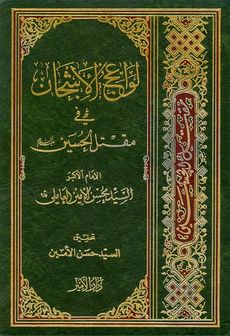Liwa'ej al-Ishjan fi Maqtal Al-Husayn (Book): Difference between revisions
No edit summary |
No edit summary |
||
| Line 25: | Line 25: | ||
| En_title = | | En_title = | ||
| translator = | | translator = | ||
| En_publisher = | | En_publisher = | ||
| En_fulltext = | | En_fulltext = | ||
Latest revision as of 16:02, 30 January 2023
 | |
| Author | Seyyed Mohsen Amin Ameli |
|---|---|
| Original title | لواعج الاشجان فی مقتل الحسین |
| Language | Arabic |
Liwa'ej al-Ishjan fi Maqtal Al-Husayn is a book written in Arabic by Seyyed Mohsen Amin Ameli about the incidents of Karbala and the authentic information regarding the martyrdom of Imam Husayn and Ahl al-Bayt.
About the book[edit | edit source]
Liwa'ej al-Ishjan is a descriptive book (written in a continuous story style) about Imam Husayn’s status and uprising completed in Dhul-Qada 1329 AH. It was first published in the city of Saida in Lebanon in 1331 AH.
On the title page of the book published in Saida, it is written: “Liwa'ej al-Ishjan fi Maqtal al-Imam Abi Abdullah al-Husayn bin Ali bin Abi Talib”; whereas the cover page of this edition says its name as “Liwa'ej al-Ishjan fi Maqtal Al-Husayn”, However, the title of the book, as the author mentioned[1] at the beginning of the book is “Liwa'ej al-Ishjan”.
Liwa'ej al-Ishjan was written based on authentic books and traditions, but the author did not mention his sources. In his opinion, this book is unique and any unbiased person will understand its difference from other books.
The publication of this bestseller book was welcomed by many scholars and elites in Syria and Lebanon. It was after the publication of this book that Seyyed Mohsen Amin Ameli issued a fatwa and declared abnormal practices and Ashura superstitions haram.
Liwa'ej al-Ishjan was written based on reliable books and traditions, but the author did not cite his sources. In his opinion, this book is unique and every unprejudiced person would understand its difference from other books.[2]
Content of the book[edit | edit source]
The contents of the book include five parts:
- Introduction: This part is about the virtues of Imam Husayn, the prophecy of the Prophet, the martyrdom of Imam Husayn, and the reward of crying over him as well as a sermon and some poems by him.
- Chapter 1: This chapter includes the event related to the uprising of Imam Husayn until he enters Karbala.
- Chapter 2: This chapter is about the events of Karbala until the martyrdom of the Imam and his companions
- Chapter 3: This chapter is dedicated to the events after the martyrdom of Imam, including the appearance of redness in the sky and the rain of blood, sending the captives of Ahl al-Bayt to Kufa and Sham, their return to Madinah along with the sermons of Imam Sajjad, Hazrat Zaynab, and others.
- Conclusion : The conclusion of the book consists of two parts:
The first part is about the burial of the head of Imam Husayn and the second chapter, which is the only analytical chapter of the book, answers three questions:
- Why did Imam Husayn go to Kufa with his family even though the benefactors had forbidden him?
- Isn't the Imam’s uprising an example of throwing himself into destruction?
- How to explain Imam Husayn not pledging allegiance to Yazid and Imam Hasan pledging allegiance to Yazid?
In response to the first question, Seyyed Morteza's opinion mentioned in the book Tanziyyah al-Anbiyyah is used that the situation in Kufa was such that at first if Imam had reached there, the goal would have been achieved, but later the situation changed. After quoting Seyyed Morteza's opinion, the author considered it incorrect and said that he was aware of the outcome of his move to Kufa and knew that he would be martyred and his duty, as Ibn Tawoos has also said, was to accept martyrdom.
In response to the second question, it is pointed out that the uprising of the Imam is not only an example of destruction but also a sacrifice of life in the way of God.
In response to the third question, it has been said that he was commissioned to rise, just as Imam Hassan was commissioned for the peace treaty; And the obligation of both doesn't need to be the same thing.
Liwa'ej al-Ishjan was translated into Persian by Nasser Pakparour under the title “Imam Hussayn (AS) was Hamase-ye-Karbala” and published by the Islamic Research Unit of Baath Foundation in 1987 for the first time.
This book is also published in Farsi with the title "Ashq wa Matam dar Sog-e-Sabat-e-Khaatam".